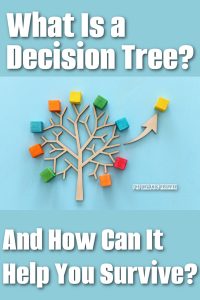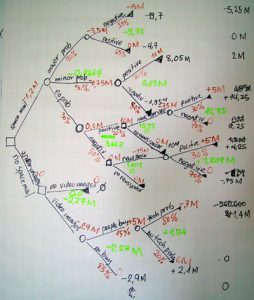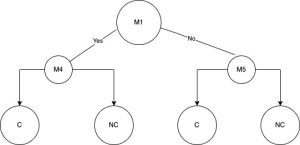If you're new here, you may want to subscribe to my RSS feed. Thanks for visiting!
Author of How to Prep When You’re Broke and Bloom Where You’re Planted online course
There are times when one second is all you have between life and death. At times like that, your ability to think rapidly and circumvent your natural freeze response can mean the difference between being a survivor and being a victim.
But, the question is, how on earth do you make decisions that quickly when you don’t have time to think your actions through?
The answer is, by thinking this through in advance.
Of course, we cannot predict every scenario we may experience. Some things are so shocking that they appear to come out of left field. A friend of mine said recently in an online group chat where we were discussing the Hamas attacks, “If I looked out my kitchen window and saw guys parachuting into my backyard with guns, I have no idea what I’d do!”
I said, “Shoot them. There’s no justifiable reason anyone would ever do that in the US.”
Why was that my first response?
Because I use decision trees on a regular basis to wargame scenarios and speed up my own responses. This is an activity that anyone of any fitness level and any economic situation can do and it’s a great preparedness exercise. But what is a decision tree? Let’s talk about it.
What is a decision tree?
This is a model I learned about when I took a business course online. I immediately thought of its application to non-business uses when I heard about it.
It is an analysis that helps you to determine possible outcomes, assess risks, and predict your chances for success if certain actions are taken. Here’s an explanation from Wikipedia.
A decision tree is a decision-support hierarchical model that uses a tree-like model of decisions and their possible consequences, including chance event outcomes, resource costs, and utility…
…A decision tree is a flowchart-like structure in which each internal node represents a “test” on an attribute (e.g. whether a coin flip comes up heads or tails), each branch represents the outcome of the test, and each leaf node represents a class label (decision taken after computing all attributes). The paths from root to leaf represent classification rules.
In decision analysis, a decision tree and the closely related influence diagram are used as a visual and analytical decision support tool, where the expected values (or expected utility) of competing alternatives are calculated.
A decision tree consists of three types of nodes:
- Decision nodes – typically represented by squares
- Chance nodes – typically represented by circles
- End nodes – typically represented by triangles
Decision trees are commonly used in operations research and operations management. If, in practice, decisions have to be taken online with no recall under incomplete knowledge, a decision tree should be paralleled by a probability model as a best choice model or online selection model algorithm.
Another use of decision trees is as a descriptive means for calculating conditional probabilities.
Decision trees, influence diagrams, utility functions, and other decision analysis tools and methods are taught to undergraduate students in schools of business, health economics, and public health, and are examples of operations research or management science methods.
These are things you can write down but once you get the hang of it, you can also create them in your head to help you to make decisions. The following photos are some visual examples of decision trees. The factors in them don’t matter – it just shows you how they work.
So, the way it works is, you have your starting point – the top of the tree – which is the beginning of the problem you are trying to solve. Next you have your potential actions. There could be two or three different choices here. Then, you have your potential outcomes for each action, both good and bad. Your outcomes may also require decisions which is why some trees have more branches, depending on the complexity of the problem. You can also do it as an “if yes then THIS” and “if no then THAT” format for simplicity’s sake.
How does this apply to survival?
Let’s go back to my friend’s hypothetical situation of seeing guys parachute into her backyard with automatic weapons. The first question here for me to answer in my decision tree is, “What reason would anyone have to parachute into my suburban yard with a large rifle?”
Then, I could go along with possible answers to that question.
- It’s our own military.
- It’s a criminal escape gone wrong.
- It’s some kind of crazy gang warfare.
- It’s a terror attack.
- It’s literal Red Dawn.
None of these options is a good one, is it? Is there any situation in which this is going to be okay?
- If it were our own military, they wouldn’t be landing in my backyard. If a member of our own military was, for some bizarre reason, parachuting into my backyard, they wouldn’t be holding a rifle ready to open fire on people the second they land. He wouldn’t be part of a group landing in my yard if he’d had to bail out of a plane – he’d be the only guy.
- If it was a group of criminals escaping from custody by parachuting out of a plane (I watch too much TV, clearly), they’re ready to take people out.
- If it’s gang warfare, this is some next-level stuff and it’s not going to go well for anyone who just stands there.
- If it’s a terror attack, they know what their next action is, and it will be to create as high of a death toll as possible they can the moment they’re stable enough to shoot.
- Red Dawn? See above.
So out of all those possibilities, the only one in which it would be wrong to shoot would be if the people landing were members of our military or law enforcement. The likelihood of that is pretty dad-gum low. (Of course, the likelihood of anyone looking out while doing the dishes and seeing gun-wielding paragliders is also low, but clearly, it can – and did – happen.)
When you see something THAT out of the ordinary, surprise is on their side, not on yours. They already know what’s happening. Two things have the potential to save you – your ability to process the information fast and take action or dumb luck. Which would you prefer to rely on?
You can use this as a mental exercise whenever you watch the news or read about current events. I regularly read true crime, and when I do, I think through the things that are happening to the victims. What could she have done to save herself? How could she have prevented that outcome? It’s not about blaming the victim. It’s about not being the victim should I find myself in a similar scenario.
Now obviously, if you run into a shocking emergency, I don’t expect you to pull out the paper and markers and draw yourself a tree as shown above. But if you get into the habit of thinking things through in this kind of organized fashion, it will help to move you past the freeze response, speed up your decision-making process, ask yourself the urgent questions, and move on to action much faster.
What could go wrong?
This isn’t foolproof. The same friend who brought up the “what if” scenario reminded me of something we learned when we went to Prepper Camp. We took a fantastic class together about psychological warfare given by Hakim Isler. He brought up a very important point that sometimes we come up with answers in our heads that seem perfectly reasonable and rational, but what we’re really seeing is something we’ve never even considered before. Maybe it’s simply something outside of our experience, or perhaps it’s such a wild card that it never crossed our minds.
You must always leave room in your decision tree for a wild card like that. There could always be something you never considered. But use this to allow yourself to collect more information. Don’t let it paralyze you.
Ways to wargame
There are a lot of different ways to wargame extreme scenarios, and a lot of them are actually entertaining. I’m a regular player of the What If Game. I have been since I was a little girl. (Yes, it used to drive my parents crazy.)
 I still play the What If Game. Here are some opportunities for What-Iffing and making decision trees:
I still play the What If Game. Here are some opportunities for What-Iffing and making decision trees:
When you watch or read the news, if a particular story catches your eye, do some research. Learn more about what happened from multiple sources, then put yourself in the position of the people who experienced it. Make a decision tree – what are the possible reasons X is happening? What is the appropriate response to each of those reasons?
When you read prepper and survival fiction, think through the story. How the characters respond might not be how you respond. How would the scenario be different in your location? How would you respond? How could you protect yourself? Is there anything you can do in advance to make a bad outcome less likely? Here are some awesome books for adults our readers enjoyed and here are some for children and teens.
When you watch television shows or movies, do the same thing. It doesn’t even have to be incredibly realistic for you to drop yourself into that world and wonder, “What if?” Here are some movies with a survival or preparedness theme, or you can find a series here to binge-watch.
Thinking through any scenario helps you to come to solutions more quickly when time is of the essence. It can be an enjoyable activity for the whole family, and you just never know when thinking fast could save a life.
Thinking about emergencies before they happen is critical.
We cannot possibly predict every bad thing that could ever happen but we can predict some of them. By wargaming the ones that are possible – and we know they’re possible because we saw that it happened to someone else – it can help us to cut down on our decision-making time if something similar happens to us.
A long time ago, I was discussing the human freeze response with a friend of mine who served in active war zones for years. He told me that he doesn’t have a decision process when he sees the enemy coming over the hill. It’s automatic for him to raise his rifle up and shoot. He has so much training and so much experience in situations like this that his response times are honed to milliseconds.
But the rest of us may not have a similar background.
We all want to stop…hit pause…take a second to think things through. But that is not always possible. I fear we are looking at a future that is far more dangerous, what with heated events in the world and declared enmities. The likelihood of us being present when something horrific happens has just gone up.
Will you be ready to take action if it happens to you? This is an article that can help you stay safer. You can purchase How to Survive During Dangerous Times, a 661-page PDF book that contains this and other articles to help you improve your responses to crises, prepare your home, and improve your OPSEC.
Have you heard of decision trees before? Have you ever used them in your workplace? Is it something you could see yourself applying to preparedness and survival situations?
Let’s discuss it in the comments section.
About Daisy
Daisy Luther is a coffee-swigging, adventure-seeking, globe-trotting blogger. She is the founder and publisher of three websites. 1) The Organic Prepper, which is about current events, preparedness, self-reliance, and the pursuit of liberty; 2) The Frugalite, a website with thrifty tips and solutions to help people get a handle on their personal finances without feeling deprived; and 3) PreppersDailyNews.com, an aggregate site where you can find links to all the most important news for those who wish to be prepared. Her work is widely republished across alternative media and she has appeared in many interviews.
Daisy is the best-selling author of 5 traditionally published books, 12 self-published books, and runs a small digital publishing company with PDF guides, printables, and courses at SelfRelianceand Survival.com You can find her on Facebook, Pinterest, Gab, MeWe, Parler, Instagram, and Twitter.



















13 Responses
It would be good for you to look at Nassim Talib writings on being snti-fragile. Good stuff there.
This can have a place in training certain people who have trouble making decisions. But basically it causes overthinking the situation, which is more dangerous in a survival scenario. Although it has limited applications in business, it is also the cause of may of the problems we see today in business. It makes business planning weak, slow and unprepared (because they think they have it all planned out).
There is an old adage: Those who can’t do it, become Teachers…..
(Because if they really could do it, they would be out making tons of money doing it, instead of teaching about it.)
Here are some of the things you should know about survival;
1) Is that most plans fail.( but that you should still have a basic plan).
2) That you can’t think of (or plan for) everything.
(This is all about change and adaptability. Decision trees put you in a box)
3)And that seconds,(or milliseconds) count.
(This is often the biggest issue as to deciding whether you will survive or not.)
War gaming or “what if’s” can be good to develop thinking skills, even in making basic plans, but beware as they are also a trap. Inflexibility, arrogance and being blindsided, are often the result of “having it all planned out”. The “what If’s”, can also be a sign of indecisiveness or a lack of decision making skills.
In WW2 in Africa, when American troops entered the Battlefield; some of the British Generals learned why the Americans were more successful against the Germans. Despite their lack of training and battle experience, It was their ability to quickly adapt on the battlefield to new scenarios. Something British planning methods did not account for.
if you need a decision tree to make decision with, you are lost (or dead) already.
Instinct and “going with your gut”, is all about making decisions on the fly. When you don’t have time to stop and think, because your Plan A, failed.
BTW, chances are that if your Plan A failed, your “pre planned”, (decision tree format), Plan B will also,. Because neither one probably considered the new realities, that caused your Plan A, to fail.
People are creatures of habit. If your “habit” is to need a decision tree, you will have trouble making decisions on the fly.
Which will probably lead to your quick demise.
So learn to quickly think on your feet, fly by the seat of your pants, etc.
Yo Mic…..I think you missed the point!!!! Decision trees can be very helpful in trusting your gut and making decisions on the fly. It helps to get out of the mud before it dries and you’re stuck. Would not to be your partner in a panic situation.
LW
Yeah. What he ^^^ said.
Actually people who use decision or thinking trees have highly organized minds and then, having thought out possibilities before hand, can then quickly apply them to the situation. Then, having thought it through, if and when the situation changes, they just adjust accordingly.
People who tend to “fly by the seat of your pants,” tend to panic or make very poor decisions having not thought the situation through previously.
How many times have we seen a young person, having not the experience, not having thought things through, pin-ball though life, living by the seat of their pants, from one bad decision to the next.
If they are lucky, they recognize their predicament and do something about it to get out of the destructive pattern. Could be stop hanging out with a group of people. Getting a better job. Going to college and applying themselves. Or even joining the military.
Below, David Levin and Jerry D Young make some very good points
“Have you heard of decision trees before?”
Yes. Some of my long-time editing clients worked in industries for which decision trees seem especially suitable. Probably the main application I’ve been exposed to is oil & gas exploration, which often calls for estimating the expected value of various options (drill further vs. abandon the well, for example).
“Have you ever used them in your workplace?”
Not directly, but my work as a systems engineer often required anticipating various scenarios and deciding how the system should handle each one.
“Is it something you could see yourself applying to preparedness and survival situations?”
Probably to some extent. I imagine there are aspects of decision trees that we apply frequently without necessarily being aware that they can be formalized (as you describe).
When I said above, that I’d probably use decision trees to some extent, I was referring to aspects of preparing a decision tree, such as identifying uncertainties. As I understand decision trees, they’re mainly intended for situations in which the identified potential outcomes can be expressed in a common way (such as in monetary terms).
An example might be if one had to decide on what combination of two types of food to stockpile, where the less expensive of which has a shelf life of 5 years, and the more expensive of which has a shelf life of 20 years. The decision would depend in part on how soon one would start consuming the stockpiled food, which (let’s assume) in turn would depend on the timing of SHTF. So, if one bought a 5-year supply of the less expensive type, and SHTF doesn’t occur for 4 years, then 4/5 of one’s stockpile would expire before one consumed it. To use a decision tree to help determine what combination of the two types of food might be best, one would identify certain candidate combinations of food and several time frames for SHTF and assign a likelihood to each time frame. The result of the decision tree might be framed as the number of years of effective food supply after SHTF.
Unfortunately, most of us lack solid information for assigning a realistic likelihood to uncertainties such as when SHTF might occur. This seems to make it more difficult to construct a realistic “preparedness” or “survival” scenario for which full-blown decision trees could be useful. But as I noted above, some of the input to a potential decision tree could nonetheless be relevant by itself.
(I hope that at least some of this comment is intelligible to those unfamiliar with decision trees. I quite understand Daisy’s deeming it impractical to try to cover the details in her article, leaving it to her intrepid viewership. 8^) )
Great article. Coming from the industrial world myself, it´s a good idea to make them for general guidelines, thus avoiding the imposition of too many limits to your options.
I have used them in business. While I like the concept, and do use it as part of my prepper planning, it is a more modified form than the original. And no, I do not try to run through a formal decision tree.
What I am getting from Daisy’s article, just like much other prepper planning, is to use decision trees now, as practice during ‘paper’ training, so, as you do field training the process becomes not second nature, but first nature, just as OpSec and situational awareness can and should develop.
Having thought about hundreds (literally) of possibilities, with pretty much each one of them having alternatives, the process is automatic with me. I am 70 years old now and my mental acuity is not quite what it was, but most of the training, including situational awareness, OpSec, and decision trees as part of situation response are still an integral part of my daily living skills.
I know many people say to not do any scenario planning and training, and while I understand their reasoning, to a degree and believe if scenarios are rigidly structured and the responses to them rigidly structured they are correct.
However, if scenarios for planning and training are set up with a great deal of flexibility, the planning and training will take into consideration those variables and if anything remotely similar to the basic scenario occurs I will have thought of and planned for and trained with them in mind. Not one set piece of a scenario and single response to that and that alone.
And the way I plan and train, I am using decision trees constantly to address things that come up. Not always with a written or drawn decision tree (or one of the several variations now being used with the same or alternative names), but mentally. Which not only locks the actual process in my mind, but the use of the process instantly when any form of new situation occurs to, first, determine if it is a danger to me and any responses. And if the decision tree process indicates that it is not a danger to me, then another follow on decision tree snaps into mind which goes through the various other possibilities.
Since I have done it so much it is automatic now and decisions often are made in a matter of seconds. Sometimes less than a second. And they are reasoned decisions, not the first I might come up with, but a decision based on the decision tree process, streamlined in my mind through use,
I am part of a prepper group that stays away from apocalyptic survival training, political issues, conspiracy theory related disasters. Pretty much your basic natural and smaller scale human-caused (note that I use ‘human-caused’ not man-made due to the fact that I have seen almost as many situations caused by women that were disasters as I have men) disasters and how to deal with them.
I, on the other hand, am an apocalypse and doomsday scenarios prepper. With many variations of a list (now) of over 200 ‘disasters’ with 24 more or less personal or family disasters, and 22 ‘disasters’ that can and often do, occur after many of the primary disasters occur.
I will freely admit several are pretty far fetched, but not out of the realm of possibility, I believe. By running these scenarios through my head, at the very least, and running a decision tree based on whatever comes to mind as I let my mind deal with whatever enters my mind in relation to the scenario.
After running through the process several times when I have the time to do so, I will come up with a multitude of responses to each nuance of the scenario based on where each ‘tree limb’ takes me.
I have spent a great deal of time doing this since I did have the time. It can be easier with a small, cohesive group that can provide feedback and helpful suggestions and options. The result is the same. Broad basic plans with plenty of room for dealing with situations that occur that were not considered during the training for that basic scenario, and since many other scenarios have been gamed and will have included similar details that have solutions plotted, it can all be done if/when that scenario, in some form, occurs.
Decision trees, use them now, constantly, to be able to do it in your mind nearly instantaneously when something happens.
This my long, rather rambling set of thoughts on decision trees.
Just my opinion.
The WEF had a brilliant one worked out to finite detail on their website for Covid back in 2020, since removed because it pointed to conspiracy (as it turns out to be fact). I see its back again, more sophisticated with more junk added like climate change.. https://www.weforum.org/agenda/2017/11/what-is-a-transformation-map/
Decision Tree, also more commonly known as a mind map in the rest of the world is used frequently by corporates.. powerful stuff if used correctly, it can pre-empt almost anything. Good for prepping for sure, but expect the unexpected also.
This is a true story, when I was a teenager, I was babysitting when the eldest girl I was watching and I talked about what to do if there was a fire. About a year later, that girl found herself in a fire and she survived because we had discussed the possibility of what to do if either of us were in that circumstance. Having contingency plans does pay off!
Whenever I’m working our my options, I create a list. I always add something to the end and that is: ‘Something else’. Doing this makes me try to think further, otherwise we can get stuck in our ways.
Too complicated for my brain. Not the wondering “what if” and thinking through likely responses but the pen to paper part. The way my brain works I would get lost in the rules of getting it “right” in writing and lose the actual intent of the process. I “what if” all the time.
This is a great article, Daisy. I am training to be a first responder now and they teach us to play the “What-If Game” in our heads alllllll the time, when we are sitting in our vehicle, on the way to a call, off-duty at the grocery store, etc. They tell us to rehearse even unlikely scenarios in our heads because “our bodies won’t follow where our mind hasn’t gone.” Exactly like you said, it’s about reaction time and overcoming that freeze response so you can act instead.